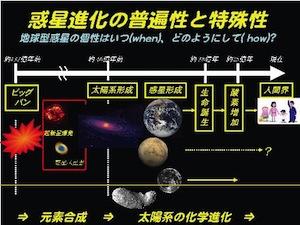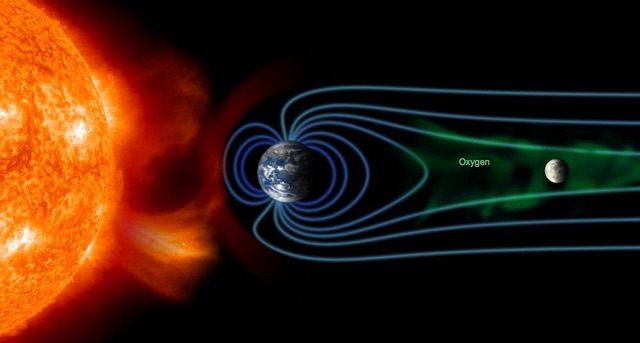
Terada Lab. Home > Research > Origin and evolution of the solar system
Origin and Evolution of the Solar System
Isotope cosmochemistry

In the 4.6 billion years of solar system history, planetary material fragmentation due to collisions between celestial bodies has been a frequent event. Especially during the early stages of the solar system evolution from dust to planetesimals to protoplanets, the collision/coalescence process and the collision/fragmentation process were proceeding simultaneously. Information on the early-stage evolution of the planetesimals is known to exist in the form of sub-millimeter size crusts in meteorite breccias formed due to repeated collision and fragmentation processes.
In-situ isotope analysis is a method to determine the age of a meteorite from the isotopic ratios contained in the fine-scale meteoritic structures.
We have been working on in-situ uranium-lead dating of phosphate minerals using a high-sensitivity, high-resolution ion microprobe (Secondary Ion Mass Spectrometer: SIMS). Phosphates are uranium-rich minerals with a relatively high closure temperature and are widely found in natural materials. So we can determine the absolute ages for not only igneous/sedimentary rocks of the earth but also micro-fossils and various meteorites. Furthermore, a three-dimensional isochron method using two types of U decay sequences, 238U and 235U, makes it possible to derive a crystallization age and metamorphic age (impact age) of the meteorite simultaneously. Using this method, we succeeded in the in-situ dating of the lunar breccia and the granite-like crust in the LL3-6 chondrite Adzhi-Bogdo.
We aim to decipher unknown processes in the solar system evolution by clarifying the veiled age information of polymict meteorite breccias.
Co-evolution of the moon and earth system

The Earth is protected from solar wind and cosmic rays by the Earth's magnetic field. On the night side of the earth, the side opposite the Sun, the Earth’s magnetic field is extended like a comet tail and makes a space like a streamer (we call it “Geotail”). At the center of the Geotail, there is an area which exists as a sheet-like structure of hot plasma.
In collaboration with the Institute of Space and Astronautical Science and Nagoya University, we examined plasma data of the plasma analyzer on the lunar orbiter spacecraft "Kaguya" 100 km above the Moon’s surface and discovered that high-energy oxygen ions (O+) appeared only when the Moon and Kaguya crossed the plasma sheet. It had been known that oxygen ions flowed out from the polar regions into space; however, we succeeded in observing that they were transported as “Earth wind” to the surface of the Moon 380,000 km away, a world first.
Detected O+ ions had a high energy of 1-10 keV. These O+ ions can be implanted into a depth of tens of nanometers of a metal particle. This is a very important finding in understanding the complicated isotopic composition of oxygen on the lunar regolith, which has long been a mystery. Through this observation, we demonstrated the possibility that components that lack 16O, which is a stable isotope of oxygen and is observed in the ozone layer, a region of Earth's stratosphere, were transported to the Moon surface and implanted into lunar soils.
Exploring the planet formation with magnetic physics
In a galaxy, amorphous interstellar dust is known to be aligned by weak interstellar magnetic fields. This alignment is the most universal phenomenon for solid materials in magnetic fields. However, most solids in space and on Earth are diamagnetic or weak paramagnetic. Since their magnetic properties are not well understood, it is unclear why the interstellar dust is aligned.
 We have found out that even materials that do not contain magnetic ions are aligned in a low magnetic field. To elucidate the origin of diamagnetic anisotropy which causes alignment, we are conducting research using magnetic physics techniques.
We have found out that even materials that do not contain magnetic ions are aligned in a low magnetic field. To elucidate the origin of diamagnetic anisotropy which causes alignment, we are conducting research using magnetic physics techniques.
The interstellar magnetic field is an important factor controlling the formation of stars and planets. Observation of the polarization generated by the alignment of amorphous dust has revealed the magnetic field structure in the star-forming region. By observing the polarization of the dust disk in the proto-solar system in the same way, it is expected that the magnetic field structure will be verified. Therefore, we are researching to show experimentally that amorphous particles present in these regions and considered to have no anisotropy align in a low magnetic field.

Moreover, we have found that when a diamagnetic particle is placed in a microgravity environment, a remarkable translational motion is caused by a magnetic force. We believe that this magnetic translation can explain the elemental differentiation associated with planetary evolution, and we are conducting experiments to verify it.
As described above, we are conducting research to clarify the basic characteristics of diamagnetism that was overlooked in the terrestrial environment, and based on the results, we are tackling unsolved problems in planetary science.
